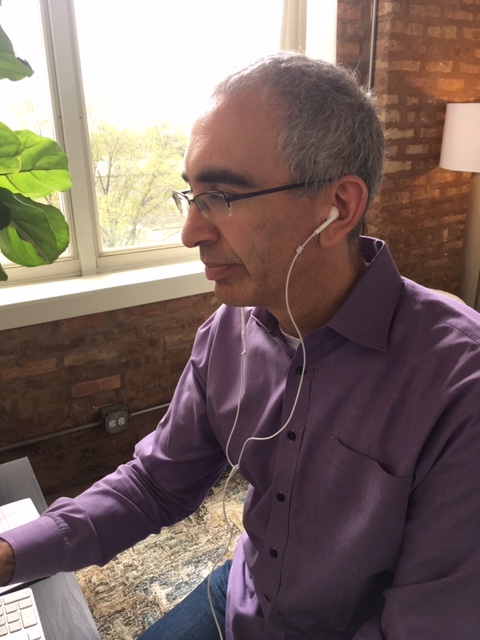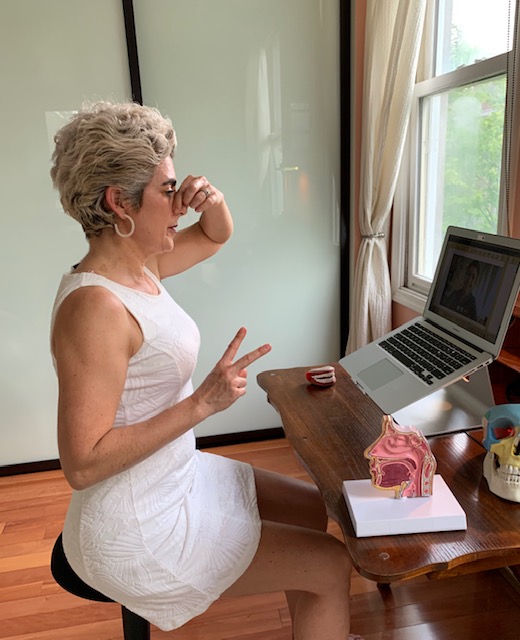Covid 19 blew in like a massive gust of wind. Quickly the invisible enemy brought death and destruction causing us to say goodbye to loved ones, shelter in place, fear for our lives, lose our livelihoods and for the first time avoid medical treatment. Millions of Americans in a flash had to scramble to find ways to manage their own health, from serious illness, to everyday checkups, to injury prevention and rehab, to steps to build their immune system to ward off disease. Overnight Doctors devised a new way to treat the sick using Telemedicine. I spoke with numerous Health Care professionals about how it works and their biggest challenges. Two who stood out are Dr Jennifer Hobson, Physical Therapist & Founder of Hobson Institute in Chicago and Dr John Stracks, Founder and Director, John Stracks, MD, LLC, Assistant Clinical Professor of Family Medicine, Northwestern Medicine.

What plan did you set up ?
Dr Stracks: We decided that anyone with suspected COVID-19 needed daily monitoring so that we could catch any decompensation early and get people to the hospital at the appropriate time. As soon as people have symptoms, they contact us, we decide whether they need treatment, and then we touch base with them by email, phone, or video every day for 2 weeks or until we feel that they’re in the clear.
How is your Telehealth unique?
Dr Stracks: As far as we know, we were the first physician’s practice to set up this kind of monitoring system. Since then, major medical centers (such as Northwestern in Chicago) have followed suit and have had good results with the plan.
How can you tell if it is successful?
Dr Stracks: We set a goal at the beginning of the outbreak to have a zero percent mortality rate. Not only have we done that but we also had zero patients on ventilators or even in the ICU.
Is Telemedicine just as beneficial as seeing someone in person?
Dr Stracks: We’ve been practicing Telemedicine for years and probably did 1/3 of our appointments remotely even before COVID-19. Currently we’re seeing every patient remotely. Occasionally I wish that I could examine someone, but 99% of the information I need I can get during a remote visit.
Does Telemedicine help calm fears during the pandemic?
Dr Stracks: Our patients have greatly appreciated our being open through this pandemic. We expanded our hours at the beginning and answer our phones 24/7, so no one has to worry that they won’t be able to reach us. We’ve also been able to see everyone who calls and wants an urgent-care appointment the same day or the next day.
What will medical care look like as we move forward fighting Covid 19?
Dr Stracks: Telehealth is clearly here to stay. While the pandemic is still going on I would expect a vast majority of visits to be through Telehealth. Even once the pandemic calms down, I would expect significantly more Telehealth appointments moving forward.
What has been your biggest challenge ?
We had to wade through all the information about COVID-19 at the beginning to find out what was relevant and how to manage it. Since initial reports said that many people did fine for the first week of symptoms but got much sicker the second week, that’s how we decided on the daily monitoring so we could watch that evolve in real time.
Can you share a patient story?
Dr Stracks: We got a call from a colleague who didn’t have insurance and was struggling to breathe about 7 days into her COVID symptoms. We got her a pulse oximeter so we could monitor her oxygen levels, and we talked with her twice a day for the next two weeks. Her breathing got better and then worse and her cough was significant. 14 days in, she got significantly more short of breath, and we decided to treat her with Azithromycin, one of the controversial treatments for the virus. This helped her significantly and her course turned around. By 21 days she was feeling quite good and is feeling excellent now. She never had to go to the hospital.

Dr Jennifer Hobson is a European trained Physical Therapist who specializes in treating head, neck, spine and temporomandibular disorders. Unique breathing techniques are key to her practice and have been essential for patients during the Covid 19 pandemic.
How is your Telehealth unique?
Dr Hobson: I am trained to provide Myofunctional therapy and breathing retraining and can help my patients through Telemedicine. Access to the video provides enough information to guide the patient through simple posture adjustments with tongue and soft palate exercises to help improve airway diameter, reduce snoring, and even begin reversing sleep apnea.
How can you tell if it is successful?
Dr Hobson: The breathing training techniques we facilitate can reduce many symptoms such as anxiety, cold hands and feet, snoring, and headaches.
Is Telemedicine just as beneficial as seeing someone in person?
Dr Hobson: In certain cases, telemedicine is just as effective. Through visual observation of the patient and Q&A, patients are provided guidance and advice. In the event when a patient requires manual therapy or hands-on treatment, we can sometimes guide the patient to attempt some manual treatments, but this is not always effective. I have experience guiding patients through self-releases to alleviate pain or discomfort, but there is little that can replace a skilled pair of hands to address treating the exact joint or muscle problem.
Does Telemedicine help calm fears during the pandemic?
Dr Hobson: I think that having the option of Telemedicine is not only a viable option for providing therapy, but also it is an outlet for those suffering from isolation. Many people continue to feel unsafe leaving their homes and visiting unfamiliar locations where they could be exposed to unnecessary risks. My experience with remote breathing training has been very positive. I have taught patients to retrain nose breathing to prevent breathing through the mouth. I have been providing more lessons virtually and through social media during this pandemic. With any airborne virus, we must make sure we are using our nose to effectively filter the air and release the nitric oxide that sterilizes the air within the sinuses. That does not happen in the lungs through mouth breathing, this is important to realize and simple to practice.
What does Telemedicine look like in the future?
Dr Hobson: I believe that Telemedicine is here to stay, at least until we gain more control over the spread of this virus. I also believe that this is a window into the possibilities modern technology will provide us in the future as we are now forced to “fast forward” our techniques to accommodate these challenging circumstances. We will always need to be able to access medical help. We are now fortunate to have the tools to provide this without forcing patients to leave their home. We never know what the future will hold and what other challenges it might bring, but we have found solutions to make a significant difference in the health of our patients through Telemedicine.
What was your biggest challenge?
Dr Hobson: Telemedicine is in its infancy and many are not familiar with it or comfortable using it. We have many patients that are opting to delay their treatments until the level of infection risk is significantly reduced, but this could create other issues by delaying their treatments. The work to explain how Telemedicine can guide patients through a simple progression of exercises or specific myofunctional therapy exercises is significant but not impossible. We are finding success with many that are willing to try telemedicine, get in front of their computer or mobile device, and follow direction as they would in person. The advice and procedures we provide help improve posture, enhance airway diameter, and rest overall tone of their face and shoulders, alleviating pressure and providing relief.
Can you share a patient story, how you helped someone?
Dr Hobson: We began Telemedicine sessions with a patient who experienced years of snoring and feeling daily fatigue. I taught him how to reduce the volume of his breath, soft palate exercises to improve his airway diameter and ways to restore nasal breathing. After his second session he was able to understand the techniques we were working on and he began to keep up the nasal breathing. This began the process of reducing his snoring, allowing he and his wife to sleep more soundly. Snoring is a precursor to sleep apnea and should never be ignored. This patient was able to eliminate his snoring in 3 Telehealth visits. Remember that breathing seems to be something we all know how to do, but don’t forget that with many things, we develop bad habits. Retraining our breathing patterns can reverse these bad habits and provide the relief that can’t be found in prescription drugs or other forms of “correcting” these issues, such as CPAPs.
To learn more about Dr Hobson’s practice visit www.HobsonInstitute.com


